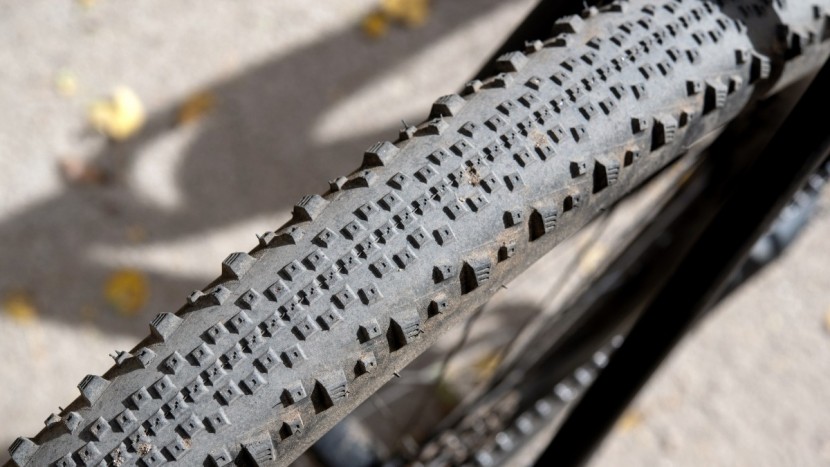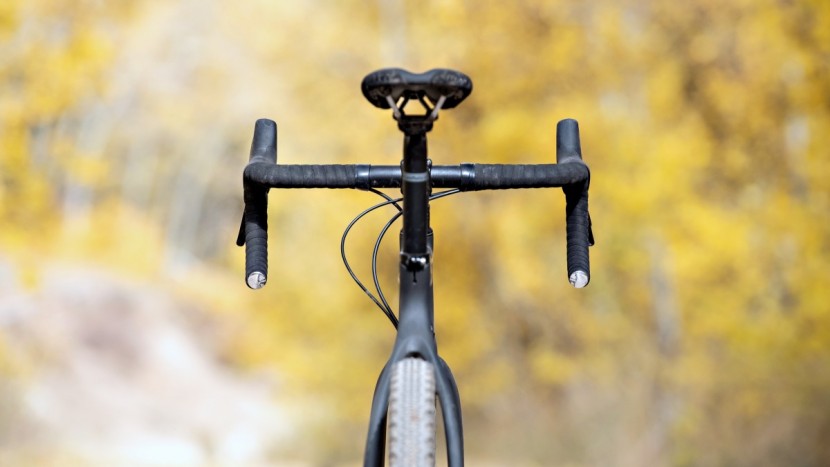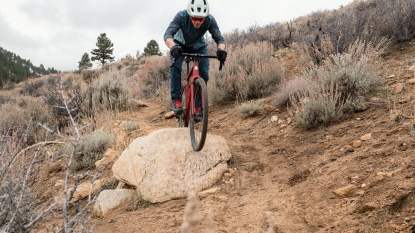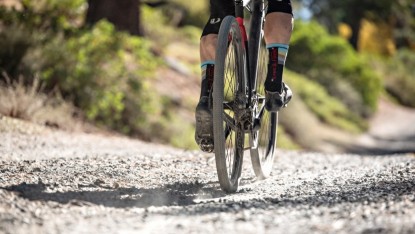Ibis Hakka MX Rival Review

Our Verdict
Our Analysis and Test Results
The Ibis Hakka is no longer offered in the black color we tested. It now comes in Salt Water Taffy (white with orange and black accents), Wizard Potion (Lavender with purple accents), and Sacre Bleu (black with light blue and yellow accents). -January 2023
Frame Design
The Hakka MX features a full carbon fiber frame with an ENVE G-series gravel-specific carbon fiber fork. This frame is impressively lightweight and ultra-stiff. It has an oversized bottom bracket and sculpted chainstays to accommodate tires up to 700 x 40c or 27.5" x 2.1". The fork has clearance for up to 700 x 50c or 27.5" x 2.25" tires. It features 12mm thru-axles, flat-mount disc brake mounts, and front and rear fender mounts. It also has internal cable routing that can work with any drivetrain configuration and internally routed dropper posts. The Hakka MX comes in 5 sizes: 49, 53, 55, 58, and 61cm.
We measured our size 58cm test bike and found a 573mm effective top tube length and a 392mm reach. The head tube angle was 72 degrees, with a 73.5-degree seat tube angle. The bottom bracket sat 276mm off the ground with 430mm long chainstays and a 1040mm wheelbase. Our test bike tipped the scales at just 18 lbs and 13 oz set up tubeless without pedals.
Ibis redesigned their Hakka cyclocross race bike a few years back to modernize its geometry to meet the demands of the growing gravel riding scene. In doing so, they created the Hakka MX, a highly versatile bike suitable for everything from hardcore gravel racing to bike packing adventures. The MX stands for “monster-cross” and makes light of the fact that they offer it with 700c wheels and tires or a 27.5" x 2.1" monster-cross setup. The Hakka is built around a lightweight and stiff carbon fiber frame that is incredibly fast and efficient with a snappy and race-inspired feel. The frame's stiffness gives it surgically precise handling. However, the lack of compliance can sometimes feel harsh compared to the competition, a tradeoff for its unparalleled efficiency. The Hakka's geometry is in line with modern gravel bike trends, and this bike is comfortable for casual group rides and 100-mile endurance races alike.
Design Highlights
- Carbon fiber frame only
- Frame weight of only 1000-grams
- 700c or 27.5" wheels
- Tire clearance up to 700 x 40c or 27.5" x 2.1"
- Threaded bottom bracket
- Frame and fork only for $1,999
- Complete builds ranging from $4,599 (tested) to $4,899 (Shimano GRX) with the option to upgrade to carbon wheels for an additional $849
Downhill Performance
The Hakka MX is straight-up fast. On the descents, it excels on smoother and more manicured gravel conditions with razor-sharp handling and uncompromising precision. The carbon frame is very stiff, giving this bike its impeccable handling and responsiveness. However, this stiffness results in a ride quality less forgiving than some of the competition. We had the chance to test the Hakka MX with both the stock wheel and tire combinations available on the Rival build, though most of our time was on the 27.5" setup.
The lightweight carbon fiber frame of the Hakka is STIFF. It is undoubtedly the stiffest frame of all the models we tested, and this works a bit of a double-edged sword for this bike's downhill performance. On the one hand, this bike is fast; it accelerates like no other and has razor-sharp handling. On the other, the limited compliance of the frame does little to absorb vibration and road chatter, which can make it feel a little harsh over the rough stuff. This bike is an absolute rocket down the hill without outrageous power transfer, efficiency, and a race-inspired feel on mellow singletrack, smooth gravel, or pavement. It's also super fast over rough gravel; you just feel the feedback more than you do on other, more compliant frame designs. The geometry feels dialed and comfortable, almost identical to the Stigmata but with a slightly lower bottom bracket, touch longer chainstay, and slightly lower front end. Testers found this geometry allowed for a relaxed enough position for all-day comfort with the ability to get down into an aggressive attack position when needed.
We had the chance to try both the stock wheel and tire combinations offered for the Rival build during testing. Not surprisingly, the 700c wheels and tires offered a distinctly racier, faster, and more refined feel. These would be our choice if we were splitting our time between pavement and gravel, if our typical gravel rides were relatively smooth and buffed, or if we were racing the Hakka in some endurance gravel events (which we did). The 27.5" wheel setup is a bit slower rolling but provides heaps more traction and dampening in the form of air volume. These would be our choice if our gravel roads were rough or chunky, if we planned to ride any singletrack, or if we were planning on doing any bike packing. We like that Ibis gives you options when you buy, helping to ensure you get the proper setup for your needs. Ibis also gives you upgrade options to get carbon wheels at an additional cost.
Our testers were generally impressed with the Rival build on our test bike. This component spec is quite similar to the Stigmata we tested and works well for the intended application of the Hakka. While the build isn't high-end or especially fancy, everything works well and doesn't compromise the bike's overall performance. Our only real gripe with the build we tested was the narrower, non-flared stock Ibis Flat-Top handlebar. While this handlebar provides a relatively comfortable place to rest your hands, our testers much preferred the feel of wider bars with flared drops. Ibis does give you the option of upgrading your Hakka with an ENVE G-Series gravel bar for an additional cost, and the handlebar would be the first upgrade we'd make to enhance the downhill performance of this bike.
Climbing Performance
The Hakka MX is a speedy and efficient bike on the climbs, and it earned one of the top scores for the group with a 9 out of 10. This efficiency is thanks to the bike's lighter weight and the frame's stiffness which allows for a very direct transfer of your power to the drivetrain. Sure, the frame transmits a little more feedback than some, but there is absolutely no loss of power when pedaling this bike. If you're interested in going uphill quickly, the Hakka has you covered.
The very nature of rigid bikes makes them all quite efficient when climbing, but few can match the Hakka in this regard. Our test bike weighed less than 19 lbs, complete with 27.5" wheels and girthy 2.1" tires. This was the lightest bike we tested, and you can feel the difference over the course of long and short climbs. When you get on the gas, the bike responds immediately, whether you're grinding it out in the saddle or punching it up a short rise. It has a very snappy and lively feel due mostly to the stiffness of the frame. You don't need to be a racer to appreciate this bike's climbing abilities; those who take a more casual approach will still be rewarded by its efficiency over the course of any length of ride.
The Hakka's geometry is generally quite comfortable for climbing with a properly steep seat tube and a moderate length reach. The modern gravel geometry works well, whether you are settled in for a long, slow grind with hands on the top of the bars or down in the drops sprinting uphill for glory. The components are generally dialed for the climbs as well. The SRAM Rival 1x11-speed drivetrain has plenty of range for just about any pitch of climb, and you don't need to fiddle with any pesky front derailleur. Testers preferred the 700c wheels and tires for smoother road surfaces, though the 27.5" setup was great for rougher roads where the benefits of additional air volume were more appreciated.
Versatility
The Hakka gets a nod for its versatility right off the bat because it is offered with either 700c or 27.5" wheels. This gives the consumer the ability to select the wheel and tire setup they prefer depending on their intended use. With such a lightweight and stiff frame, the Hakka works well for road rides, and with the big tires, you can rip this bike around on some mellower singletrack trails.
We've also seen some custom builds with short-travel suspension forks and flat handlebars to create a super lightweight hardtail. While the frame and fork don't have mounts specifically for bike packing accessories, we have seen many Hakka's loaded with handlebar, saddle, and frame bags for bike packing adventures.
Weight
Our size 58cm Hakka MX takes top honors for its impressively low weight. At just 18 lbs and 13 oz set up tubeless without pedals, the Hakka is the lightest bike in this test, coming in 5 oz lighter than the next lightest model.
The light weight is especially impressive because this is the entry-level Rival build. This is primarily the result of the ultra-light 1000-gram frame weight and modest but lightweight component spec. Climbs feel easier, and this bike feels incredibly lightweight and fast underneath you. For the price, this bike is very lightweight, and we'd imagine that anyone building up their own dream bike on a Hakka frame could make one significantly lighter.
Build
The build of a bike entails specs such as drivetrain, wheels, pedals, and more. In our tests, the quality and functionality of a bike's build account for 10% of its overall score.
The Hakka MX we tested comes with the SRAM Rival build. This is far from the flashiest component specification, but it is lightweight and functional and helps to keep the price of this lightweight carbon bike from being completely astronomical.
Groupset
Our test model came equipped with a full SRAM Rival kit, which includes the drivetrain and the brakes. This is a 1 x 11-speed drivetrain that pairs a 40-tooth front chainring with a wide range of 11-42-tooth cassette. Ibis chose stiff and lightweight Praxis Zayante Alloy cranks with a 30mm spindle and a threaded bottom bracket. The SRAM Rival, hydraulic disc brakes are flat mount with 160mm rotors, front and rear.
Wheels/Tires
When you buy a complete Hakka MX you have the option of standard 27.5" or 700c wheels and tires. We bought the 27.5" wheeled version which comes with Ibis branded 733 Alloy rims laced to Ibis hubs. These rims have a 29mm inner rim width which pairs well with the 2.1" Schwalbe Thunder Burt tires. These tires have lots of air volume and a semi-slick tread that features very low profile center tread with some slightly more substantial cornering knobs. If you opt for the 700c wheels, you get the same Ibis hubs laced to a set of Stan's Grail Alloy rims with Schwalbe G-One 700 x 38c tires mounted to them.
Cockpit
The cockpit features a handful of house-branded Ibis components. The Ibis Flat Top alloy handlebar is a relatively standard non-flared drop bar with a wide “flat-top” that is quite comfortable. The bar comes wrapped with basic EVA bar tape, and the handlebar is clamped to an Ibis alloy stem that comes in a 70, 80, 90, or 100mm length, depending on frame size. The seat post is an Ibis aluminum in a 31.6mm diameter and 350mm length. Our test bike came with a WTB Silverado Pro saddle in a 142mm width, and you have the option of a WTB Koda Pro in a 150mm width if you prefer a wider and softer seat.
Build Options
The Hakka MX is offered as a frame only with the ENVE G-Series carbon fiber gravel fork for $1,999 for riders who want to create their own custom dream build. Otherwise, Ibis offers it in two complete builds including the Rival build we tested. You can purchase the Rival build with either the 27.5' x 2.1" wheel and tire combo we tested or with Stan's Grail Alloy 700c wheels for the same price. Ibis also provides upgrade options for several components including the handlebar, stem, seat post, and wheelset at an additional cost.
The GRX build is the other option that retails for $4,399 and comes with the Shimano GRX gravel-specific groupset. This build has a full GRX 1x drivetrain, GRX brakes, and comes standard with an ENVE G-Series gravel handlebar, road stem, and carbon seat post. You can also purchase it with either the 27.5" or 700c wheels with the option to upgrade to carbon rims in either wheel size.
Suggested Upgrades
The Hakka MX with the Rival build is very capable and ready for just about anything straight out of the box. Testers did feel that the stock Ibis Flat Top handlebar was a little narrow for their preferences, and the lack of flare made it somewhat less comfortable than the wider flared bar that came on the Stigmata, for example. The handlebar would probably be our first upgrade on this bike, and it's also an upgrade option if you configure your component specification on the Ibis website.
Testers also found that the stock Schwalbe Thunder Burt tires that came on our test bike weren't the most durable. If you ride seriously rough and rocky roads or trails, you may find the limitations of these tires quickly. Tires are an affordable upgrade and will eventually be a necessary purchase if you ride with any frequency anyway. Beyond that, the Hakka is about as ready to rip as we'd expect for the price.
Should You Buy the Ibis Hakka MX Rival?
We feel the Hakka is a great choice for aspiring or current gravel racers or anyone seeking a very lightweight and efficient bike for their adventures. While it is fairly expensive, we feel that the Hakka MX Rival is a solid value when considering its excellent performance. This is a high-performing lightweight carbon rocketship of a bike that is equally at home toeing the line at gravel races as it is casually spinning out the miles on paved or dirt roads with friends. We think the price-to-performance ratio is quite high with the Hakka MX, and we recommend it to anyone seriously considering getting into the gravel racing scene.
What Other Gravel Bikes Should You Consider?
The Hakka MX is a high-performance carbon fiber gravel bike that is very fast and efficient. Considering the race-inspired performance of the Hakka we feel that the Rival build we tested is a solid value and we wouldn't hesitate to recommend it to anyone who seeks efficiency and a top-quality ride. However, the ultra-stiff frame that makes this bike so quick and ultra-responsive also sacrifices a little in the comfort department. If you are more of a laid-back rider and value comfort more than speed, you may want to take a look at some other models. The Santa Cruz Stigmata Carbon CC Apex is one of our favorite bikes that strikes a good balance between comfort and performance. The Canyon Grail CF SL 7 AXS is another affordable, high-performance option. It has an all carbon cockpit and handles quite well.
| Awards | Best for Racing |
|---|---|
| Price | $4,599 List |
Overall Score  |
|
| Star Rating | |
| Bottom Line | The Ibis Hakka MX is a very lightweight, uncompromisingly stiff, fast, and efficient gravel bike |
| Pros | Very lightweight, fast, nice build |
| Cons | Can feel harsh over the rough stuff, narrow non-flared handlebar |
| Rating Categories | Ibis Hakka MX Rival |
| Downhill (30%) | |
| Climbing (30%) | |
| Versatility (20%) | |
| Weight (10%) | |
| Build (10%) | |
| Specifications | Ibis Hakka MX Rival |
| Measured Weight (w/o pedals) | 18 lbs 13 oz |
| Frame Material | Carbon Fiber |
| Wheelsize | 700c or 650b (tested) |
| Frame Size Tested | 58cm |
| Available Sizes | 49, 53, 55, 58, 61cm |
| Wheelset | Ibis Alloy 733 27.5" rims with Ibis hubs |
| Front Tire | Schwalbe Thunder Burt 27.5 x 2.1" |
| Rear Tire | Schwalbe Thunder Burt 27.5 x 2.1" |
| Shifters | SRAM Rival 1 |
| Rear Derailleur | SRAM Rival 11-speed |
| Front Derailleur | N/A |
| Cassette | SRAM PG 1130 11-42T 11-speed |
| Crankset | Praxis Zayante Alloy 40T 175mm |
| Bottom Bracket | T47 Threaded |
| Fork | ENVE G-Series Carbon |
| Seatpost | Ibis Aluminum 31.6mm |
| Saddle | WTB Silverado Pro 142mm |
| Handlebar | Ibis Flat Top Alloy |
| Stem | Ibis 31.8 |
| Brakes | SRAM Rival 1 flat mount |
| Measured Effective Top Tube (mm) | 573 |
| Measured Reach (mm) | 392 |
| Measured Head Tube Angle (degrees) | 72 |
| Measured Seat Tube Angle (degrees) | 73.5 |
| Measured Bottom Bracket Height (mm) | 276 |
| Measured Wheelbase (mm) | 1040 |
| Measured Chain Stay Length (mm) | 430 |
| Warranty | 7-years |




















